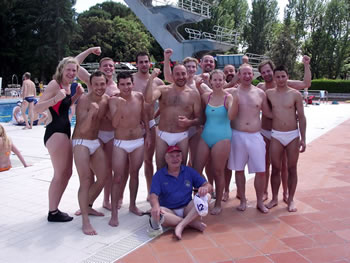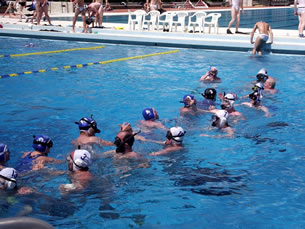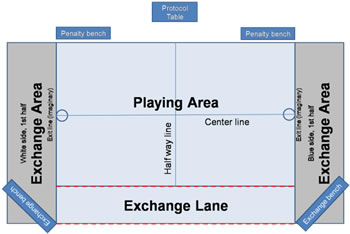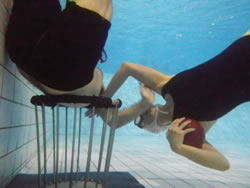Underwater Rugby Team Make International Debut
Putney's underwater rugby team performed well in their first overseas tour
Members of PURE Underwater Rugby Club, which is based at London’s Putney Leisure Centre, jetted over to Florence in Italy to take part in the Firenze Tournament competing against teams from across Europe.
Oliver Kraus and Robert Bonnar, who set up the British Sub Aqua Club (BSAC) affiliated club, were proud of how they competed against strong and vastly more experienced opposition.
The experience has made them determined to enter more international competitions and hopefully win a trophy in future.
Their efforts have earned the congratulations of Mary Tetley, the Chief Executive of the British Sub-Aqua Club, the sport's governing body.
She said:
"I was delighted they performed so well in their first ever tournament and I am sure they will go from strength to strength in future.
"Underwater rugby is a really exciting, physically demanding sport and it will I suspect grow in popularity in the UK."

Oli, as he prefers to be known, said: “There was a mixed sex competition and a women only competition. We were in the mixed sex tournament which involved 12 teams. The teams were split into four groups of three teams with each group having an expert, an intermediate and a beginners team. PURE Underwater Rugby were drawn in Group M with the home Firenze team and the German side, Biefeld-Karlsruhe.
“Unfortunately we lost one of our key players to illness on the morning of the tournament and, as we only travelled with a team of 10 to start with, we were fortunate to recruit a couple of Austrian players who were available.
“The first game, against the hosts, was really tough and we were well beaten 8-0. This was our first ever competitive match and the fact the opposition was so strong and experienced made it an impossible task.
“We did much better against the German side though despite losing 3-1. That meant we were out of the main competition. However, we then played in a subsidiary competition against the other teams that had been eliminated.
“That went very well and we won all three games beating Madrid, 2-0, an Italy mixed team 2-0 and UWR Luzem, a Swiss team, 1-0.”
 Oli added: “That was really pleasing actually as all three teams had far more experience and have been playing and competing a lot longer than us. I’m very happy with our overall achievement.”
Oli added: “That was really pleasing actually as all three teams had far more experience and have been playing and competing a lot longer than us. I’m very happy with our overall achievement.”
Oli says he set up PURE Underwater Rugby Club a decade after landing on British shores thanks to help from BSAC. He said:
“I was surprised a game I have played in numerous countries around the world, wasn’t really played in Britain. I just couldn’t find a club anywhere. Underwater rugby is a brilliant game and I used to play at home in Bratislava as well as playing in Moscow, Munich and even Boston in the United States.
“The object of the game is to get the ball into the oppositions basket. It’s played by two teams of six players who all wear snorkels, face masks, fins and coloured caps to distinguish between the two teams. The round ball is filled with sea water so it’s heavier than fresh water and is therefore negatively buoyant and doesn’t bob to the surface. Teams can have up to six substitutes and they can be used as often as a team wants.
“It’s a physical game and you need to be fit. Players need to do a lot of breath holding and we really do get through a lot of cardio work. Although it’s called underwater rugby it doesn’t have a great deal in common with rugby football to be honest.”
He added: “I initially planned on staying in the UK for just six months but ended up going to the University of Essex and a decade on I’m now working as a Database Manager and have settled in Britain. It really surprised me I couldn’t find a club here in the UK. So I set about trying to organise and form a club myself. However, it isn’t so easy as any club needs to be affiliated to a governing body so there is insurance, safety, training and proper regulation.
“BSAC gave us the opportunity to open a club under their umbrella. Without their help we wouldn’t have been able to rent a pool and insurance costs would have been prohibitive.”
Oli and Rob launched PURE Underwater Rugby Club in June 2013 along with joint founder member Roy Sherwin, of Teddington Sub Aqua Club, who is a qualified snorkel instructor.
Oli says the club currently now has 16 members, all of whom are now BSAC members. He said: “We are looking for new members and would welcome anyone who wants to give the sport a try. We have a good mix of male and female players including one lady member, a Finnish girl, who has joined after initially learning to play underwater hockey.
“And now we have represented the UK in an international tournament there will be no holding us back and we can’t wait to enter another international tournament and test ourselves against some of the world‘s top teams.”
“We meet and train every Thursday evening at 9pm at Putney Leisure Centre and we would love to welcome any potential new members down to the pool.”
*For more information about BSAC visit www.bsac.com and for more information about PURE Underwater Rugby visit the club website at www.underwater-rugby.webs.com
*To watch a PURE Underwater training video visit # www.youtube.com/watch?v=7c-fqXGpVfo
Tempted? Learn a little more about the sport...
Underwater Rugby — The Game
Underwater rugby contests match two teams of twelve players. A team may have a maximum of 6 players in the water. The reserve players may dive in when the player they replace is fully out of the pool. The action is intense. A player usually lasts for three or four dives and then exits the pool to recover.
The teams are distinguished by suit color, either blue or white. Apart from swim suits and caps (the same kind as found in water polo), the kit includes mask, snorkel and fins. Points are scored whenever a team puts a ball in the goal, of which there are two on opposite sides of the pool in the deep end. The depth of a pool must be between 3.5 meters, the shallowest allowed by the World Underwater Federation (CMAS) rules, and 5 meters, the deepest.
Much of the action takes place entirely beneath the surface. In fact, it is against the rules for the ball to leave the water completely; it may break the surface but may not be lifted out of the water. Passing is allowed in all directions. The ball, which sinks, can only be thrust a short distances because of water resistance. Underwater rugby shares many of the same characteristics as many team ball sports on land. As in hockey, basketball or football, underwater rugby players are divided by position.
The typical modern scheme has two goalies, two forwards and two defensive backs. Generally players sharing a position take turns diving. While on defense, for example, one goalie guards the basket while the other breathes at the surface before descending to takeover goal keeping. To avoid anaerobic exertion as much as possible good team players establish a rhythm that allows them to avoid both coming up the same time for air, a lapse which often creates a dangerous goal scoring opportunity.
Each player brings his own individual package of strengths. Power, speed and agility are important. Decisiveness, will power and lung capacity set some players apart. The ability to read play requires experience. Some players excel in their ability to foresee and counteract threats. Teamwork is essential to success on both ends of the pool. This interplay of factors is one reason that men and women routinely train and even compete together.
Playing Area
There are no pools specifically designed for underwater rugby. The playing area is 12 to 18 meters long and between 8 and 12 meters wide. To delineate the playing area a line with floats is strung across the pool. Parallel to that line is another that creates the three-meter wide exchange lane, giving the substitutes a place to dive in.

 Goals
Goals
The goals consist of two rigid baskets, each of which is located in the middle of its respective end of the playing area on the bottom of the pool as close to the wall as possible. The top of the basket, which is usually made of steel tubing on top of a metal base, is padded. The goals should not shift during play but sometimes do because they are not fixed to the pool bottom.
June 5, 2014